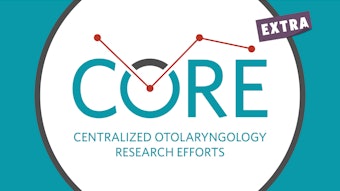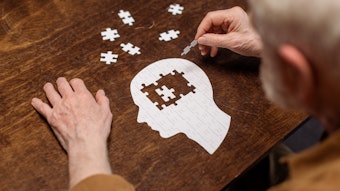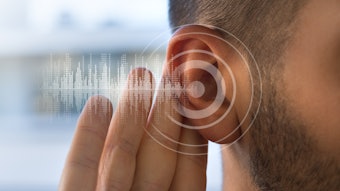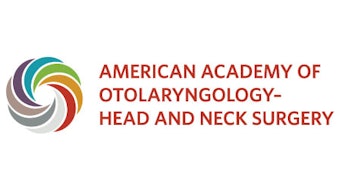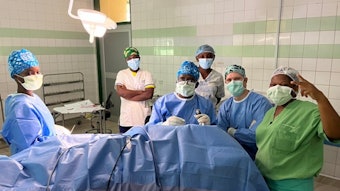Simulation in Otology: New Options for Education and Training
Although traditional cadaveric temporal bone training remains the mainstay of otologic education, the value of simulation to address challenges and elevate and improve the education opportunities for learning is clear.
Vivian F. Kaul, MD, and Maura Cosetti, MD, Chair, AAO-HNSF Otology and Neurotology Education Committee
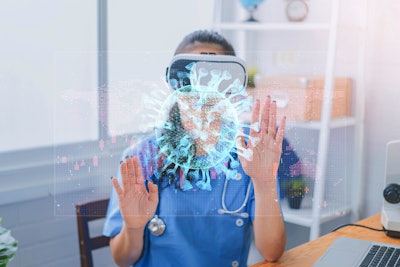
A TBL can cost upward of $2 million to construct (an estimate from >20 years ago) and are expensive to maintain.4 Many programs are finding human temporal bones increasingly hard to obtain and can be quite costly ($400/pair). Although conventional cadaveric TBLs are still the norm in many academic institutions, challenges related to cost, regulatory requirements, and access to specimens have spurred new opportunities for otologic learning, such as prosthetic temporal bones and computerized virtual interactive models.5
A variety of virtual reality (VR) software options have demonstrated some promise for otologic education. The Visible Ear Simulator (VES) is a three-dimensional (3D) stereo graphics and haptic interaction with force feedback for drilling using the geomagic touch haptic handpiece (3D Systems, SC).5 This freeware provides a tutor-guided, color-coded approach to the mastoidectomy. OpenEar Dataset is another dataset of eight temporal bones with accompanying cone beam CTs and micro-slicing of the specimen.6 This can be integrated into the VES, which allows for increased variable pathology.6
One of the primary setbacks of VR is the need for the haptic feedback using the hardware, which can be expensive ($2,500-5,000),5,7 as well as the limited osseus realism without the contralateral suction of bone dust. This immersion reality also lacks the binocular component of the microscope as well as the foot pedal of the drill for multilimb coordination. Despite that, VES is still an effective learning tool. According to Frendo, et al, the VES system can improve the mastoidectomy drilling score by 25% on the modified Welling scale.8,9 The German-made VES equivalent is the Voxelman TempoSurg Virtual Reality.10 Other simulators like the HTC VIVE VR headset (HTC and Valve Corporation, USA) allow visualization of the middle without any tasks associated with it.11
Printed bone models (PBMs) are also a popular simulation learning platform.12-16 These are 3D printed from computed tomography images and are therefore able to simulate surgery in the setting of abnormal and challenging anatomy.7,12 This modality can also have a costly initial price tag of $250,000 for the printer and materials used (up to $400), although some materials like polyactic acid and Acrylonitrile Butadiene Styrene are cheaper14. Some materials can be caustic to produce or emit volatile compounds if drilled upon. Another limitation of this model is the soft tissue consistency cannot be mimicked with the same validity as the bony consistency. In addition to addressing the limited cadaveric bone supply, PBMs provide novel education opportunities to augment training in the setting of abnormal anatomy and challenging procedures.
With increasing adoption of endoscopic ear surgery, a variety of simulation models have been developed and gained attention. A cadaveric temporal bone model showcases anatomy while also simulating cholesteatoma with fresh chicken skin to hone fine motor skills.17 Other simulators such as a wood and polyvinyl chloride model ($15),18 which later became the Otoskills Trainer, is used to train endoscopic microsurgical technique. Using an endoscope in one hand, the learner goes through a series of validated exercises to complete tasks like stacking washers on top of each other, or threading a 26-gauge wire through a needle.18 Data suggests that the learning curve associated with this trainer plateaus at the 10th repetition.19 3D printing can also provide simulated endoscopic models to teach trainees middle ear anatomy while adding in exercises.20,21 Although this simulation lacks realism, it is a self-guided learning tool that is an effective modality to adopting key surgical skills for micro ear surgery.
Although traditional cadaveric temporal bone training remains the mainstay of otologic education, the value of simulation to address challenges (such as cost and access of cadaveric temporal bone specimens) and elevate and improve the education opportunities for learning is clear. Simulation in otology is an exciting area of recent and ongoing research. The various simulation sessions at the AAO-HNSF 2023 Annual Meeting & OTO Experience in Nashville, Tennessee, featured various novel models for temporal bone education and training and allowed a glimpse into new options for otologic education.
References
- Chen JX, Riccardi AC, Shafique N, Gray ST. Are otolaryngology residents ready for independent practice? A survey study. Laryngoscope Investig Otolaryngol. 2021;6(6):1296-1299. Published 2021 Oct 13. doi:10.1002/lio2.678.
- Chen JX, Deng F, Filimonov A, et al. Multi-institutional study of otolaryngology resident intraoperative experiences for key indicator procedures. Otolaryngol Head Neck Surg. 2022;167(2):268-273. doi:10.1177/01945998211050350.
- Andresen NS, Winslow MK, Gregg L, et al. Insights into presbycusis from the first temporal bone laboratory within the United States. Otol Neurotol. 2022;43(3):400-408. doi:10.1097/MAO.0000000000003466.
- Welling DB. Personal Communication, 2/14/2010. Recently outfitted complete temporal bone laboratory with 12 stations with instructor station, approximately $2 million.
- Sorensen MS, Mosegaard J, Trier P. The visible ear simulator: a public PC application for GPU-accelerated haptic 3D simulation of ear surgery based on the visible ear data. Otol Neurotol. 2009;30(4):484-487. doi:10.1097/MAO.0b013e3181a5299b.
- Sieber DM, Andersen SAW, Sørensen MS, Mikkelsen PT. OpenEar image data enables case variation in high fidelity virtual reality ear surgery. Otol Neurotol. 2021;42(8):1245-1252. doi:10.1097/MAO.0000000000003175.
- Gadaleta DJ, Huang D, Rankin N, et al. 3D printed temporal bone as a tool for otologic surgery simulation. Am J Otolaryngol. 2020;41(3):102273. doi:10.1016/j.amjoto.2019.08.004
- Frendø M, Konge L, Cayé-Thomasen P, Sørensen MS, Andersen SAW. Decentralized virtual reality training of mastoidectomy improves cadaver dissection performance: a prospective, controlled cohort study. Otol Neurotol. 2020;41(4):476-481. doi:10.1097/MAO.0000000000002541.
- Andersen SAW, Foghsgaard S, Cayé-Thomasen P, Sørensen MS. The effect of a distributed virtual reality simulation training program on dissection mastoidectomy performance. Otol Neurotol. 2018;39(10):1277-1284. doi:10.1097/MAO.0000000000002031.
- Khemani S, Arora A, Singh A, Tolley N, Darzi A. Objective skills assessment and construct validation of a virtual reality temporal bone simulator. Otol Neurotol. 2012;33(7):1225-1231. doi:10.1097/MAO.0b013e31825e7977.
- Cheng K, Curthoys I, MacDougall H, Clark JR, Mukherjee P. Human middle ear anatomy based on micro-computed tomography and reconstruction: an immersive virtual reality development. Osteology. 2023; 3(2):61-70. https://doi.org/10.3390/osteology3020007.
- Mowry SE, Jammal H, Myer C 4th, Solares CA, Weinberger P. A Novel Temporal bone simulation model using 3D printing techniques. Otol Neurotol. 2015;36(9):1562-1565. doi:10.1097/MAO.0000000000000848.
- Wong V, Unger B, Pisa J, Gousseau M, Westerberg B, Hochman JB. Construct validation of a printed bone substitute in otologic education. Otol Neurotol. 2019;40(7):e698-e703. doi:10.1097/MAO.0000000000002285.
- Mukherjee P, Cheng K, Wallace G, et al. 20 year review of three-dimensional tools in otology: challenges of translation and innovation. Otol Neurotol. 2020;41(5):589-595. doi:10.1097/MAO.0000000000002619.
- Frithioff A, Frendø M, Pedersen DB, Sørensen MS, Wuyts Andersen SA. 3D-printed models for temporal bone surgical training: a systematic review. Otolaryngol Head Neck Surg. 2021;165(5):617-625. doi:10.1177/0194599821993384.
- Canzi P, Magnetto M, Marconi S, et al. New frontiers and emerging applications of 3D printing in ENT surgery: a systematic review of the literature. Acta Otorhinolaryngol Ital. 2018;38(4):286-303. doi:10.14639/0392-100X-1984.
- Dedmon MM, Kozin ED, Lee DJ. Development of a temporal bone model for transcanal endoscopic ear surgery. Otolaryngol Head Neck Surg. 2015;153(4):613-615. doi:10.1177/0194599815593738.
- Dedmon MM, O'Connell BP, Kozin ED, et al. Development and validation of a modular endoscopic ear surgery skills trainer. Otol Neurotol. 2017;38(8):1193-1197. doi:10.1097/MAO.0000000000001485.
- Wong K, Gorthey S, Arrighi-Allisan AE, et al. Defining the learning curve for endoscopic ear skills using a modular trainer: a multi-institutional study. Otol Neurotol. 2023;44(4):346-352. doi:10.1097/MAO.0000000000003826.
- Monfared A, Mitteramskogler G, Gruber S, Salisbury JK Jr, Stampfl J, Blevins NH. High-fidelity, inexpensive surgical middle ear simulator. Otol Neurotol. 2012;33(9):1573-1577. doi:10.1097/MAO.0b013e31826dbca5.
- Barber SR, Kozin ED, Dedmon M, et al. 3D-printed pediatric endoscopic ear surgery simulator for surgical training. Int J Pediatr Otorhinolaryngol. 2016;90:113-118. doi:10.1016/j.ijporl.2016.08.027.

